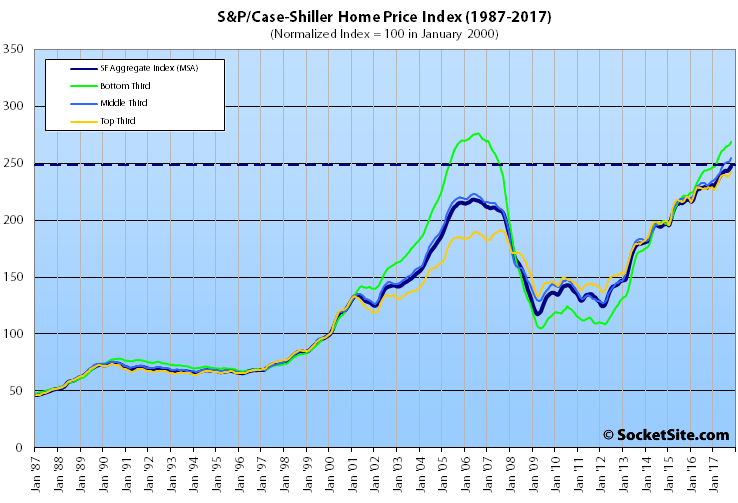Having inched up 0.5 percent in September, the S&P CoreLogic Case-Shiller Index for single-family home values within the San Francisco Metropolitan Area – which includes the East Bay, North Bay and Peninsula – ticked up 1.2 percent in October while the index for Bay Area condos slipped 0.2 percent.
With October’s gain, the index for single-family home values is now running 7.7 percent higher on a year-over-year basis with outsized gains at the lower end of the market continuing to drive the index overall.
And having ticked up 1.0 percent in October, the index for the bottom third of the market is running 9.9 percent higher versus the same time last year while the index for the middle third of the market is 10.0 percent higher having ticked up 1.3 percent from September and the index for the top third of the market is running 5.9 percent higher versus the same time last year having ticked up 1.2 percent in October.
That being said, while the index for the top third of the market is now 26.7 percent above its previous peak ten years ago, and the middle third is 14.2 percent higher, the index for the bottom third of the market still has another 2.7 percent to gain before it’s back to its 2006-era peak.
And having slipped 0.2 percent in October to an all-time high, the index for Bay Area condos is now running 5.9 percent higher versus the same time last year (versus 6.4 percent higher on a year-over-year basis in September and 7.2 percent higher in August) and 28.2 percent above its previous cycle peak in October 2005.
For context, across the 20 major cities tracked by the home price index, Seattle, Las Vegas and San Diego recorded the highest year-over-year gains in October, up 12.7 percent, 10.2 percent and 8.1 percent respectively versus a national average of 6.4 percent.
Our standard SocketSite S&P/Case-Shiller footnote: The S&P/Case-Shiller home price indices include San Francisco, San Mateo, Marin, Contra Costa and Alameda in the “San Francisco” index (i.e., greater MSA) and are imperfect in factoring out changes in property values due to improvements versus appreciation (although they try their best).

